 Features
Features
.jpg)
The Mường ethnic people share the same origin as other minority groups living in what are today the northern mountainous provinces of Hòa Bình, Thanh Hóa and Phú Thọ.
Lê Hương
The Mường ethnic people share the same origin as other minority groups living in what are today the northern mountainous provinces of Hòa Bình, Thanh Hóa and Phú Thọ.
Throughout their long history, the Mường people of Hòa Bình have determined their own way of living with and from nature.
They have discovered abundant sources of food in their natural surroundings and learned various ways to prepare and cook dishes that meet tastes and nutritional requirements and, in some cases, prevent or cure ailments. The group has formed its own customs and traditions relating to food and dining.
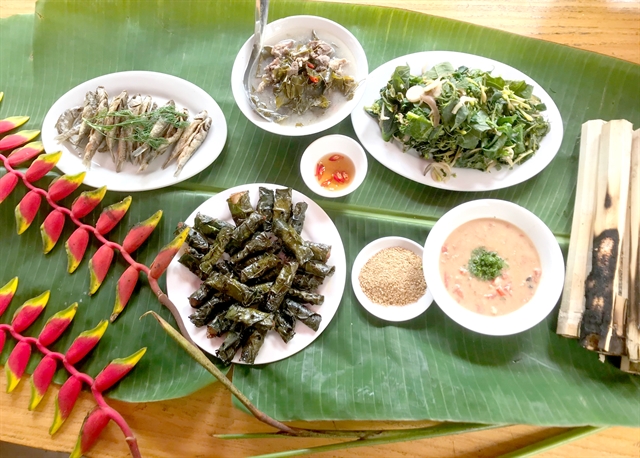
|
| TIME TO DINE: A typical meal of the Mường people presented on banana leaves. VNS Photo Lê Hương |
The following count among the many popular dishes of the Mường:
Charcoal-grilled pork wrapped in pomelo leaves
With customs depending very much on nature, various types of leaves are used in every meal of the Mường in Hòa Bình.
Grilled pork wrapped in pomelo leaves is one of the more common dishes.
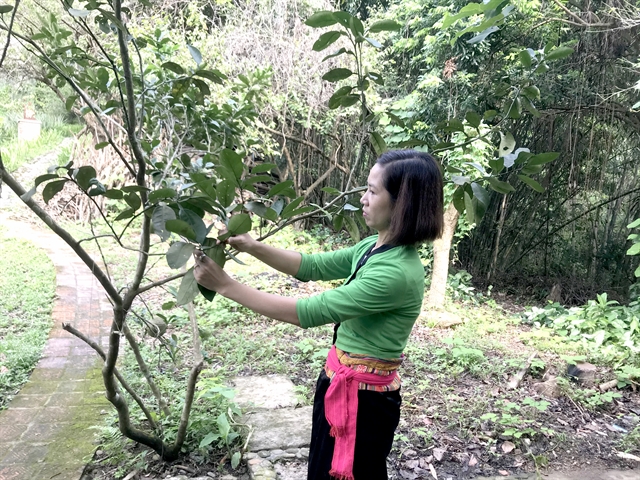
|
| INGREDIENTS ON HAND: Mường villager Nguyễn Thị Thu Hằng picks pomelo leaves for cooking. VNS Photo Lê Hương |
It’s certainly not difficult to find the ingredients, as pomelo trees are common. Young leaves that are shiny, green, and flexible are ideal.
Pomelo trees, which bear bitter-tasting fruit, are selected for the fragrant flavour of their leaves, which also boast high levels of essential oils.
The pork is home-raised. Lean and fat, it is minced or cut into thin slices and then marinated with minced onion, fish sauce, pepper, hạt dổi (seeds of a tree scientifically named Michelia tonkinensis), and other spices.
The mixture is left for at least 15 minutes before each slice of pork is wrapped in a single leaf and held together by a toothpick during grilling.
The chef should turn the rolls over and over so they do not burn. When the leaf turns grey, the pork inside is well-cooked.
“The pork should taste sweet and fatty and have absorbed the spices and essential oils from the pomelo leaf,” said Mường villager Nguyễn Thị Thu Hằng.
The pork is also dipped in green pepper and salt mixed with the baked hạt dổi.
The Mường people also consider this dish to have medicinal properties, moderating blood pressure, breathing, and digestion.
Cơm lam (steamed rice in bamboo tube)
Sticky rice steamed in a bamboo tube is a dish typical of the Mường, combining the fragrance of the sticky rice, grown on terraced rice fields, and the sweetness of the bamboo.
The rice should be freshly harvested, and flavoursome.
It is washed and soaked in water for five or six hours, then drained in a basket before being stuffed in bamboo tubes. Water is then poured down the tubes to immerse the rice.
The tubes are then covered with a banana leaf, before being baked over charcoal. It should be turned over and over to avoid burning the rice.
When steam starts to come out of the tubes and the fragrance of the rice fills the air, it’s time to eat.
The tubes are cut, leaving behind only a bamboo membrane surrounding the rice.
The steamed sticky rice can be eaten with salted sesame or grilled chicken or pork.
Buffalo and sour leaf soup
This is a simple yet significant dish of Mường people.
After being baked for a while, buffalo meat is cut into thin slices and marinated with spices and fish sauce. The meat is then stirred well and boiled until it becomes soft. A handful of lá lồm (also called lá giang and known in English as sour-soup creeper or river-leaf creeper) is added to the pot, which is boiled for five more minutes and the dish then served.
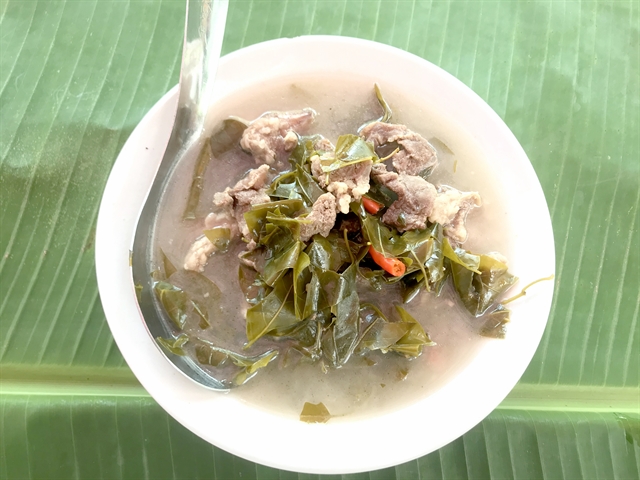
|
| WASHED DOWN: Mường sour soup is good for digestion. VNS Photo Lê Hương |
Buffalo meat is quite gamey but the sour leaves erase any unpleasant odour. The soup is tasty with the slightly-fatty yet soft buffalo meat.
It’s said that saponin in the leaves has an antiseptic function that kills bacteria like salmonella typhi and klebsiella. The leaves are also used for digestion problems and aches and pains in the bones and joints and for treating skin ulcers.
Steamed wild vegetables dipped in fish intestine sauce
The Mường people grow various types of vegetables with leaves suitable for steaming, including sweet potato, courgette, beefsteak plant, wild betel leaf, papaya, and banana.
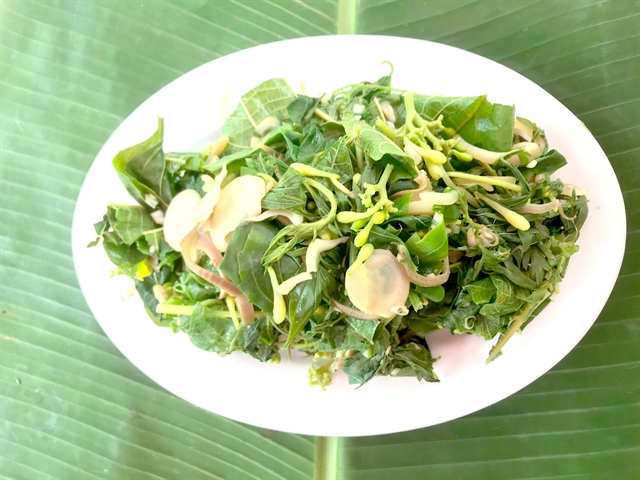
|
| MIXED PLATE: Various types of vegetables are steamed for different dishes. VNS Photo Lê Hương |
All ingredients are cleaned before being cut into small pieces and steamed in a wooden steamer.
The vegetables should be a mix of bitter, sweet, and tart, and retain their original flavour and colour after steaming.
Those that are bitter or tart can prevent the flu and enhance the body’s resistance.
In this dish, the steamed vegetables have a special flavour when dipped in a sauce made from fish intestines as well as turmeric, chilli, tomato, onion, and a little fermented steamed rice.
Carp intestines are cleaned and marinated in spices. The fish fat is then used for stirring the intestines, and all of the ingredients are placed in some water. The sauce should have a strong yellow colour, from the turmeric, and a fatty flavour from the fish intestines.
Eating the bitter vegetables with the fatty, fishy, sweet, hot flavour of the sauce is, it’s said, quite unforgettable.
Baked fish
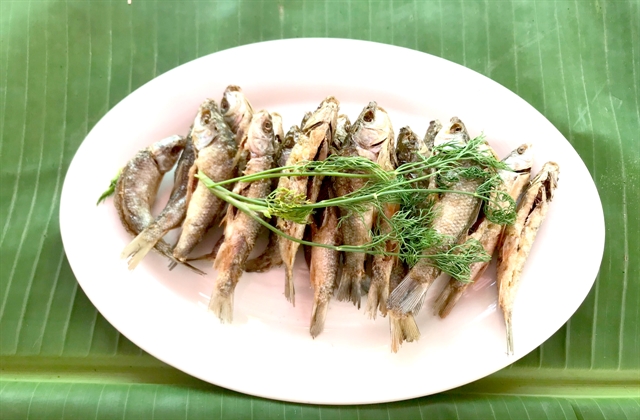
|
| NOTHING LEFT: Baked fish is both soft and tender, and the bones can be eaten too. VNS Photo Lê Hương |
Fresh fish caught from streams is yet another local delicacy. Fish the size of two fingers are marinated before being baked on charcoal.
Served hot, the dish highlights the sweet taste of the fish and can be dipped in fish sauce and chilli. Even the bones of the fish can be eaten. VNS
.jpg)



